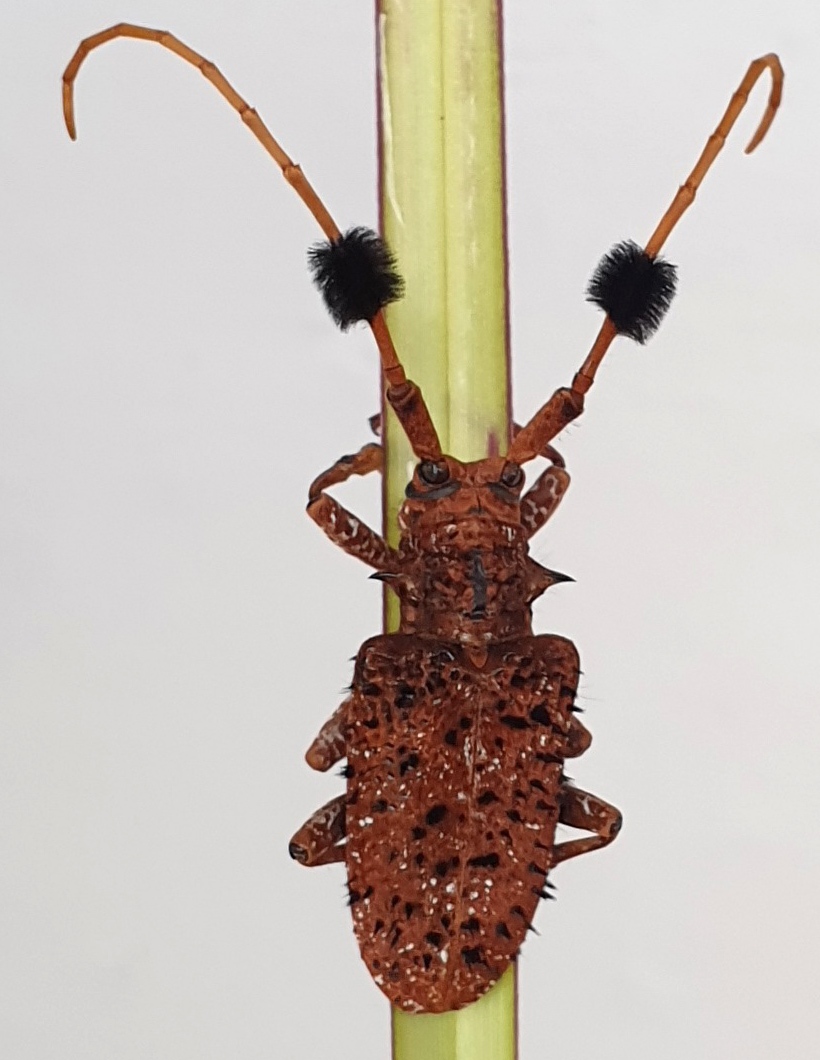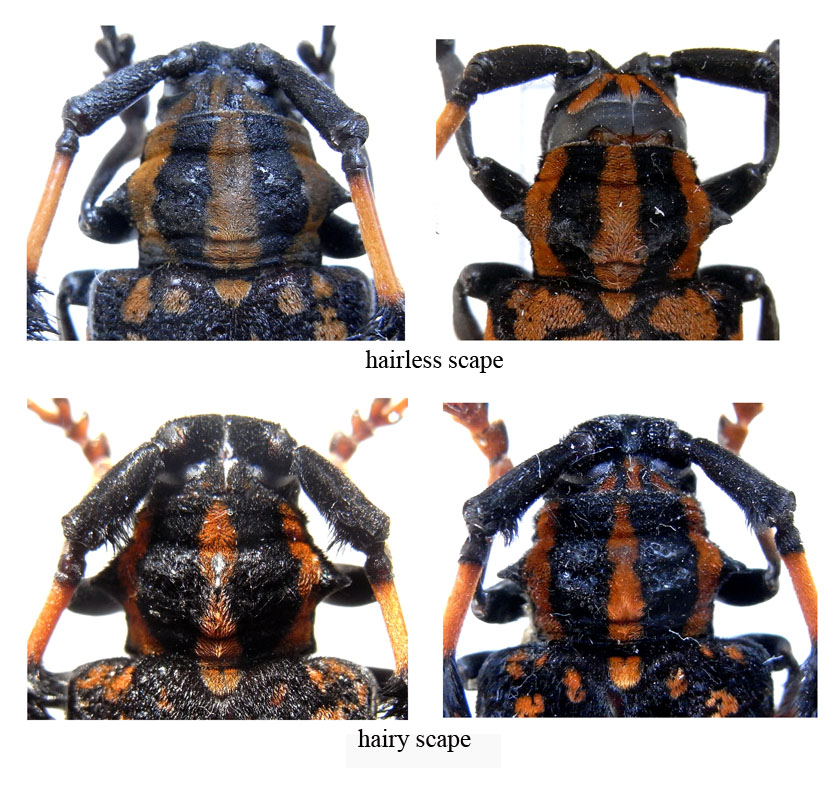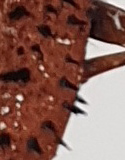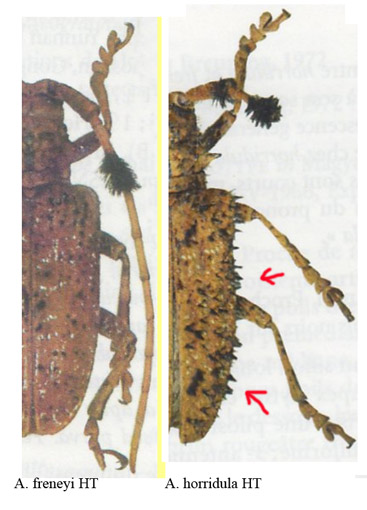| Author |
 Topic Topic  |
|
|
chris johnson
Member Nathrius
Thailand
14 Posts |
 Posted - 17/02/2023 : 14:26:17 Posted - 17/02/2023 : 14:26:17



|

495.24áKB
Hello forum,
is this Aristobia freneyi Schmitt, 1992 ?
11.07.2022
Lat: 014░47'58''N Lon: 104░17'18''E
ca. 1 km NW from Ban Sang Yai, Din Daeng, Phrai Bueng, Srisaket Thailand
Found on Jaffeg-Grass (=vetiver).
Help much appreciated.
Thx in advance and best regards from Thailand,
Chris Johnson |
Edited by - Xavier on 18/02/2023 21:13:05 |
|
|
Xavier
Scientific Collaborator
    
France
12213 Posts |
 Posted - 17/02/2023 : 15:46:57 Posted - 17/02/2023 : 15:46:57



|

296.65 KB
No, I think it is rather Aristobia horridula (Hope, 1831). |
 |
|
|
chris johnson
Member Nathrius
Thailand
14 Posts |
 Posted - 18/02/2023 : 00:50:03 Posted - 18/02/2023 : 00:50:03



|
Thx Xavier :)
There seems to be hairless scapi, that's why I thought it's freneyi. I can see something at the right scapus, but I'm not sure, because of the poor photo quality. The left scapus looks definitely hairless to me. |
Edited by - chris johnson on 18/02/2023 01:46:02 |
 |
|
|
Xavier
Scientific Collaborator
    
France
12213 Posts |
 Posted - 18/02/2023 : 08:00:09 Posted - 18/02/2023 : 08:00:09



|
| Yes, not easy. For me A. horridula has some hairs on the inner side of the scape apex, (difficult to see on the picture), but A. freneyi does not have such long tufts of hairs on the elytra (as visible on the picture). |
Edited by - Xavier on 18/02/2023 21:12:32 |
 |
|
|
Francesco
Forum Admin
    
Luxembourg
9454 Posts |
 Posted - 18/02/2023 : 08:47:28 Posted - 18/02/2023 : 08:47:28




|
| In my opinion, it is Aristobia freneyi. |
 |
|
|
Gerard
Scientific Collaborator
    
France
5299 Posts |
 Posted - 18/02/2023 : 09:08:49 Posted - 18/02/2023 : 09:08:49



|
| Hello Aristobia freneyi for me too, There is no tuft of hair on the scape. |
 |
|
|
Xavier
Scientific Collaborator
    
France
12213 Posts |
 Posted - 18/02/2023 : 09:16:18 Posted - 18/02/2023 : 09:16:18



|
The review by Jiroux & al (2014) based mainly on the tufts of hair on the antennae has always left me in doubt: I have Aristobia cf. approximator with 1, 2 or 3 tufts of hair...The same problem arises with scape hair:

209.8áKB
For the specimen in question, what about the hairiness of the elytra?

35.84áKB

77.27áKB
|
Edited by - Xavier on 18/02/2023 10:11:13 |
 |
|
|
Francesco
Forum Admin
    
Luxembourg
9454 Posts |
 Posted - 18/02/2023 : 19:30:09 Posted - 18/02/2023 : 19:30:09




|
| I strongly think that this revision should be revised... |
 |
|
|
chris johnson
Member Nathrius
Thailand
14 Posts |
 Posted - 19/02/2023 : 02:16:35 Posted - 19/02/2023 : 02:16:35



|
Hello forum,
so, the scapi definitely are hairless - the small shadows at the right scapus are due to the poor photo quality (done with a mobile phone).
And the elytra definitely have clusters of hair.

169.76áKB
Unfortunately at the time of sighting my wife and I were in the arduous process of building our house here in Thailand, so neither I had the equipment for collecting beetles nor the time.
I read that a host for A. freneyi is Butea monosperma*, and since we're living outside of the villages in the middle of rice fields, there are some of this trees around our area.
Thanks to all and best regards from Thailand,
Chris
---
*Hawkeswood/Sommung: Butea monosperma (Lam.) Taub. (Fabaceae), the first recorded larval host plant for Aristobia freneyi Schmitt, 1992 (Coleoptera: Cerambycidae: Monochamini) from Thailand. Online: https://www.researchgate.net/publication/305722464_Butea_monosperma_Lam_Taub_Fabaceae_the_first_recorded_larval_host_plant_for_Aristobia_freneyi_Schmitt_1992_Coleoptera_Cerambycidae_Monochamini_from_Thailand |
Edited by - chris johnson on 19/02/2023 06:35:42 |
 |
|
| |
 Topic Topic  |
|


